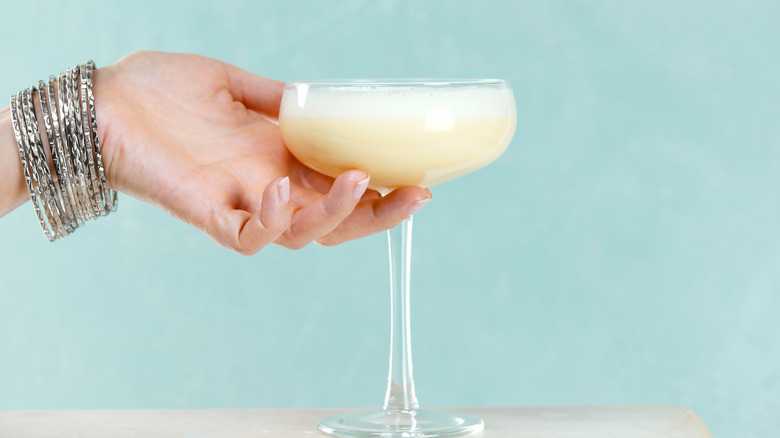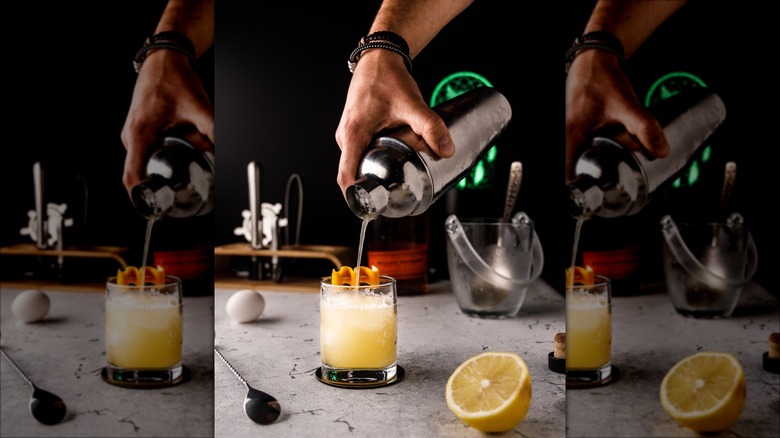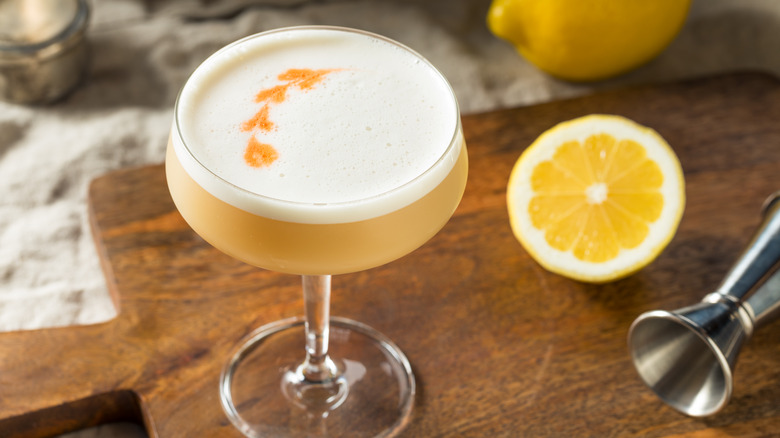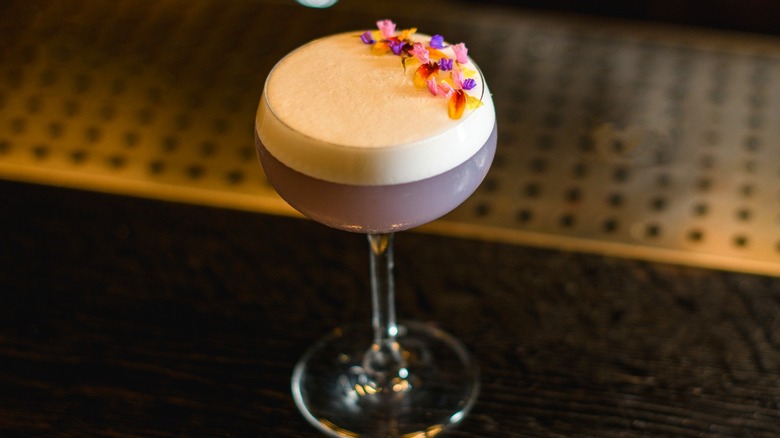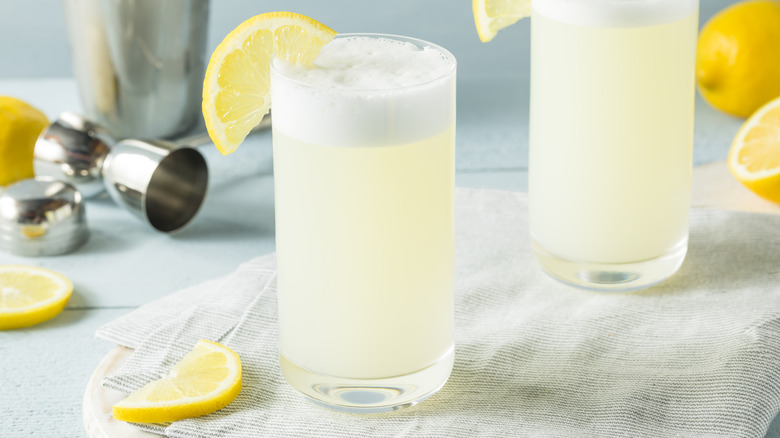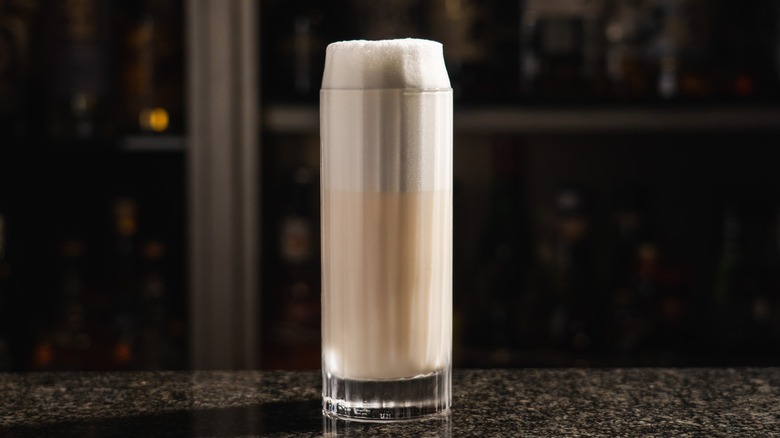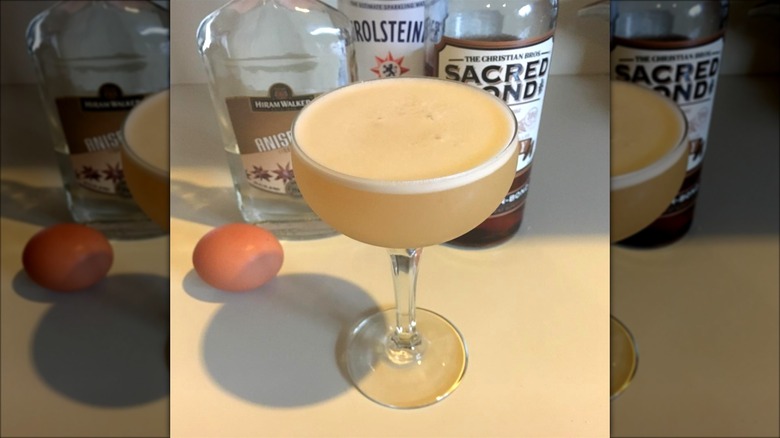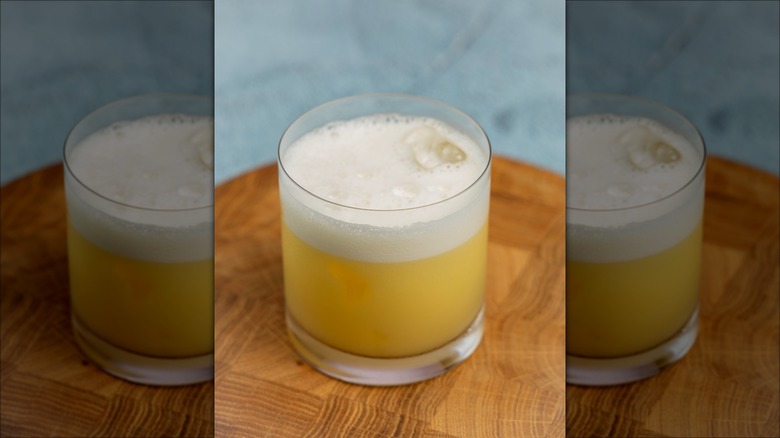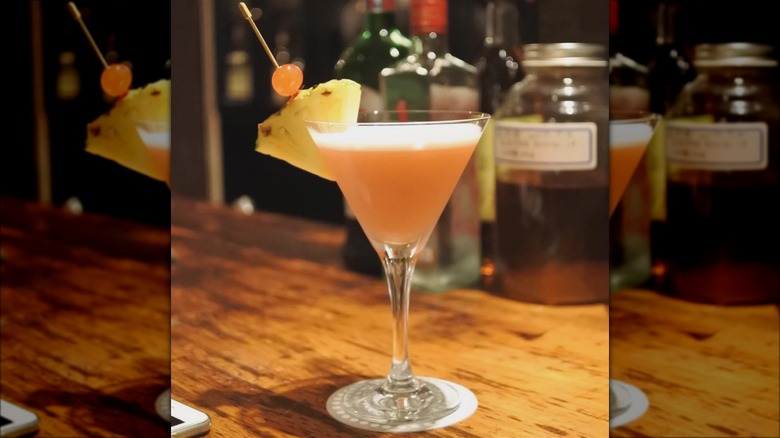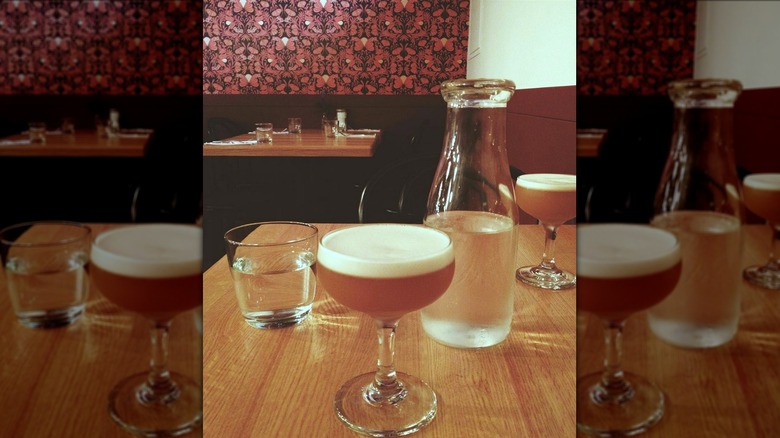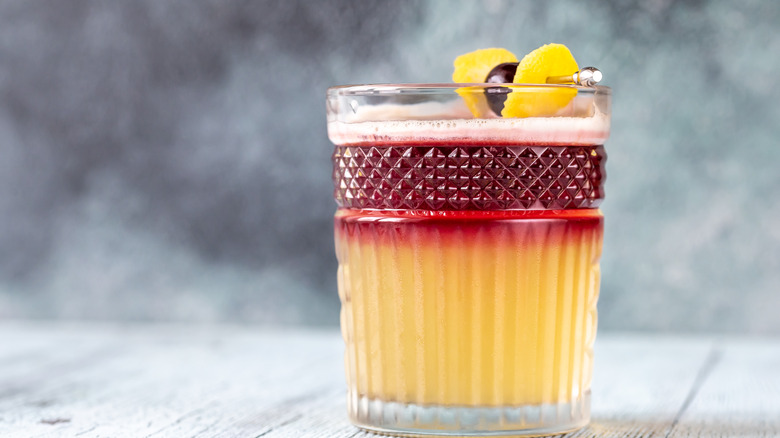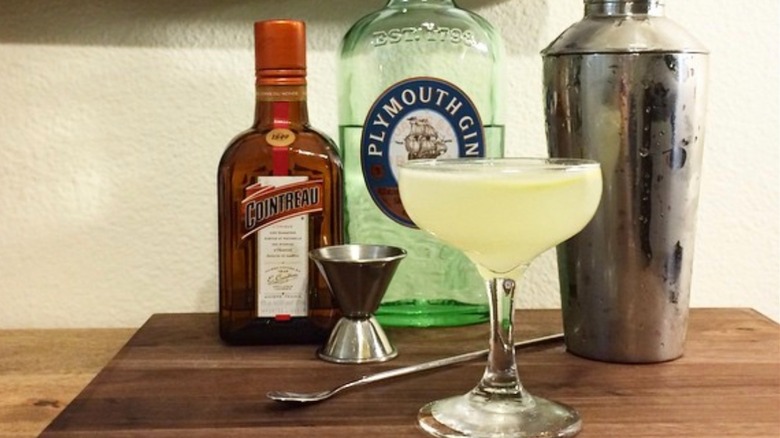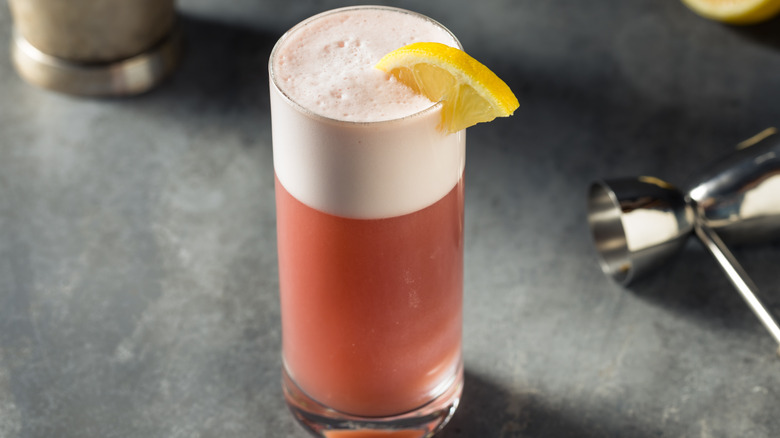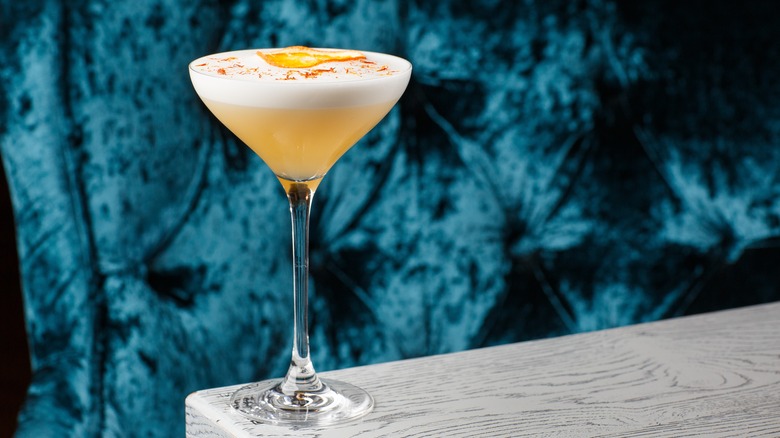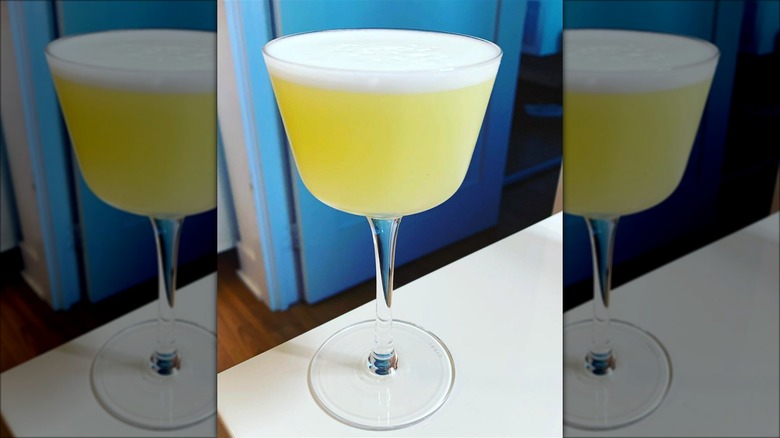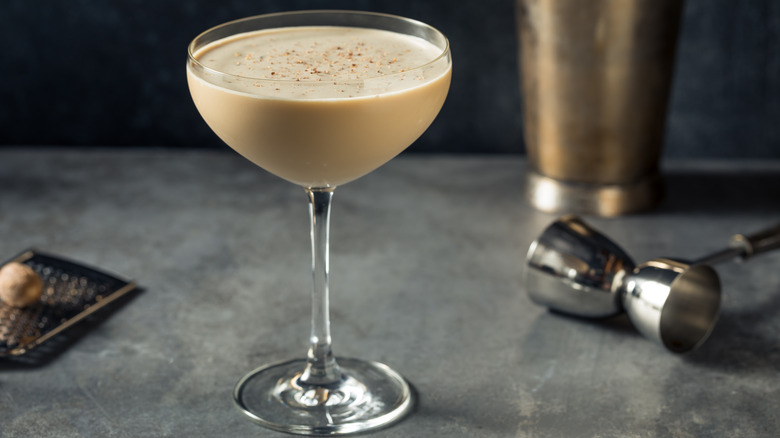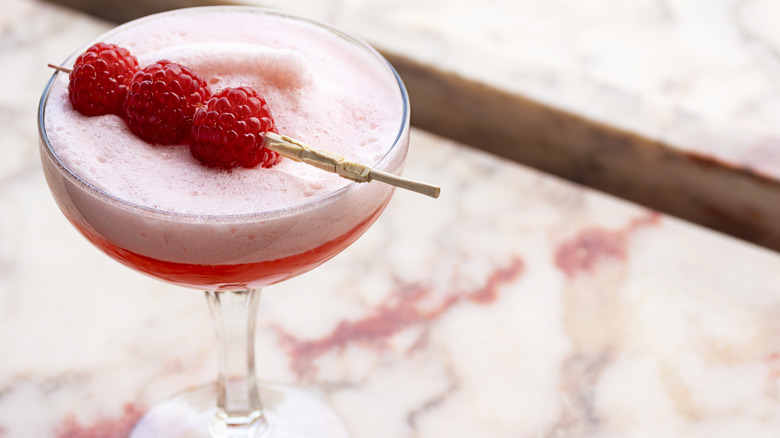16 Egg White Cocktails To Try At Your Next Happy Hour
The mere mention of ingesting raw eggs probably has you thinking about Rocky Balboa knocking back a nausea-inducing breakfast in the first "Rocky" movie, but when used correctly in mixed drinks, raw eggs are a bartender's secret weapon. Shaking an egg white with your cocktail ingredients produces a silky foam at the top of the glass that can take the edge off sour and bitter ingredients, and add creaminess to the mouthfeel. Always start by dry shaking (shaking the ingredients without ice), since dilution can limit aeration and emulsification.
There are risks in consuming raw eggs, of course, but the chances of contracting Salmonella are small from making cocktails, especially if you make sure to keep the eggs refrigerated, and wash the shells thoroughly before cracking them. You can also buy pasteurized eggs, which were heated high enough to kill any bacteria. Or even use aquafaba, a vegan alternative made from chickpea water, though it will not produce the same creamy texture as egg white.
1. Whiskey Sour
Sour cocktails date back to at least 1862 when famed American bartender Jerry Thomas published recipes for a brandy sour, a gin sour, and a rum sour in his book, "The Bartender's Guide." The common thread is a combination of a spirit, citrus (almost always lemon or lime), and sugar. As soon as the whiskey sour hit the shaker several years after Thomas's book was released, however, it became the gold standard. The simple combination of bourbon, lemon juice, and simple syrup became one of the dominant drinks of the late 19th and early 20th century, and remains one of the all-time classics.
Despite its name, the whiskey sour is a remarkably smooth drink due to the caramel notes of the bourbon. Although original recipes did not include egg white, most bartenders now add it because it offers a velvety texture that pairs with bourbon like magic. The bright, tangy lemon juice combined with the oaky, vanilla depths of the bourbon is a flavor combination that still hasn't gone out of style, more than 150 years later.
2. Pisco Sour
Chile and Peru both lay claim to pisco, the South American brandy made from distilled fermented grape juice that gives a unique flavor to the world-renowned pisco sour. Combining pisco, lime juice, simple syrup, and egg white, the drink provides a surprising diversity of flavors — from the familiar sweet and citrus profile, the creamy egg white froth of a standard sour to the perfume of the grapes, and a hint of pungency from the drops of bitters that usually dot the top.
The spirit has been a Latin American specialty for centuries, originating from a period when Chile and Peru were considered to be part of the same territory. The argument over which culture invented pisco rages on, but both countries have developed their own versions, which are so dissimilar that they may as well have different names. The Peruvian versions have to be a minimum of 38% alcohol by volume, while the Chilean versions can be as low as 30%. Peruvian pisco cannot be aged in wood, while Chilean pisco can. As with wine, the variety of grapes and the location of the vineyard also determine the flavor. For this reason, pisco sours range widely in flavor, and can suit just about any palate.
3. Aviation Blush Sour
In the early 20th century, the Aviation cocktail was all the rage. The combination of gin, maraschino liqueur, crème de violette, and lemon juice produced a mesmerizing and unusual shade of periwinkle or baby blue, and a floral, citrusy flavor. Before crème de violette disappeared from store shelves in the 1960s, the drink was at the height of glamour.
In recent years, it's come roaring back to life thanks to our unending thirst for all things retro. Variations on classic recipes can be hit or miss, but the Aviation Blush Sour is a worthy successor to its classy ancestor. Adding brandied marasca cherries, simple syrup, and egg white, it's sweet, silky, and sour in just the right measure. Marasca cherries are sour and bitter, making them unpopular for eating, but perfect for soaking in brandy and adding to cocktails. Their vivid flavor gives the Aviation Blush Sour its punchiness, and cuts through the creamy egg white like a fine perfume.
4. Gin Fizz
Fizz cocktails offer a light, more refreshing spin on sours. Built around a spirit, citrus juice, and carbonated water, they are effervescent, less intense in flavor, but equally complex and drinkable. They're so light and refreshing, in fact, that they used to be offered as a cure for hangovers, at least through the 1940s when "Trader Vic's Bartender's Guide" described them as an "early morning drink." Many fizzes use egg white, which adds a layer of cloud-like foam to the bubbles of the carbonated water, and creates a more complex mouthfeel.
A gin fizz is a simple combination of the juniper-based spirit, lemon juice, simple syrup, egg white, and club soda. Gin is a popular base for this category of drink because of its botanical flavor. When combined with carbonation and citrus, it creates a bright, fragrant drink, like walking through an herb garden on a summer's day. When making a fizz cocktail at home (probably not in the morning), make sure to add the carbonated water after you've shaken the other ingredients, or you'll end up with an untamable volcano of foam.
5. Ramos Fizz
The Ramos Fizz is known for being one of the most difficult cocktails to make. On the surface, it looks like a peculiar, yet manageable variation of a gin fizz. Joining the gin, club soda, sugar syrup, citrus juice (both lemon and lime), and egg white, are cream and orange flower water. The calling card of the drink is the height and stiffness of the foam, and bartenders sometimes compete to see who can make the loftiest version.
To make that sturdy peak of foam, however, you have to shake the ingredients for what feels like an eternity. The celebrated inventor of the drink, Henry Ramos, reportedly had 35 "shakermen" at his New Orleans bar in 1915 to shake the drink until their arms nearly came off before passing it to the next person to continue shaking. Accounts from the time claim that the ideal shaking period was 12 minutes to get the creamy, bubble-free consistency that the drink demands. Further effort is required to add the seltzer without disrupting the tightly textured meringue. To avoid withering glances from bartenders, you might want to make the Ramos Fizz at home. It takes some muscle, but there's a reason it remains one of the most celebrated cocktails: the creamy texture, floral orange water, and citrus make for one of the most rewarding drinks you'll ever taste.
6. Baltimore Bracer
The Baltimore Bracer is a relatively obscure cocktail with a controversial ingredient, but if you try it, you might find yourself making it again and again. It appeared in the 1954 cocktail book "Nip Ahoy: The Picture Bar Book" by Robert H. Loeb Jr., an author who captured the soused spirit of the 1950s and '60s lounge culture with publications like "Wolf in Chef's Clothing" and "How to Wine Friends and Affluent People."
As you might expect from these titles, the Baltimore Bracer is not a subtle drink. Brandy, anisette liqueur, and egg white are the only ingredients, and they pack a punch. The brandy provides a warm, syrupy oakiness, but it's the anisette liqueur that does most of the talking. Sweeter and lower in alcohol than absinthe or sambuca, it is still a powerful flavor, with an untempered emphasis on anise seed. The egg white is the hero ingredient in this cocktail, providing some much-needed smoothness to mellow out the bold flavors of the liqueurs. Anise is an acquired taste that some people can't stand, but if licorice is something you love, the Baltimore Bracer might be your new favorite drink.
7. Oliveto
The 19th and 20th centuries provided modern bartenders with a plethora of timeless cocktails to adapt. But every once in a while, a new mixed drink hits the scene, and elbows its way into the ranks of the classics. The Oliveto is just such a drink. Created by Minneapolis bartender Pip Hanson in 2011 for the launch of his trendy Marvel Bar, it's made with an unusual ingredient, olive oil, to create a silky-smooth texture when combined with egg white. Gin, simple syrup, lemon juice, and Licor 43 (a Spanish liqueur made with 43 ingredients), round out the drink.
When you try an Oliveto, you'll wonder why olive oil isn't used in mixed drinks more often. When shaken long enough, the oil and egg white emulsify, creating a texture that is softer and creamier than meringue, with a hint of olive flavor. Combined with the kaleidoscope of flavors in Licor 43 and the lemon juice, the drink is sweet, citrusy, botanical, and above all, smooth as freshly ironed silk.
8. Million Dollar Cocktail
The Million Dollar Cocktail was invented in the late 19th or early 20th century by either famed Singapore bartender Ngiam Tong Boon or his mentor, Louis Eppinger at the Grand Hotel in Yokohama, Japan. Regardless of which man was its true creator, the Million Dollar Cocktail became all the rage in 1920s Japan, and it's easy to see why. The combination of gin, pineapple juice, sweet vermouth, grenadine, and egg white creates a sophisticated drink that isn't nearly as sickly sweet as the ingredients suggest.
The secret to perfecting the recipe is all in the proportions. The grenadine, which some may associate with the vivid red hue and sugar-logged flavor of a Shirley Temple, should be used with the utmost restraint. One teaspoon will suffice. The pineapple juice should also be added sparingly. When the right balance is struck, the juniper notes of the gin will have plenty of room to shine, along with the herbal flavors in the vermouth. Egg white gives the drink its smoothness, and while you probably won't be paying the bartender a million dollars to make the cocktail, you'll feel like a 1920s millionaire while drinking it.
9. Cynar Sour
Egg white is a strange enough addition to a cocktail, but what about artichoke? Cynar is an Italian bitter liqueur made from artichoke and 12 other unnamed plants, that is often served over ice with soda or tonic before a meal. It does, in fact, taste like artichoke, but somehow it works, especially when used in mixed drinks. The vegetal, sweet, bitter flavor provides a welcome aberration from the spirits that usually provide the foundation of a cocktail, especially when paired with the creaminess of an egg white.
For those who are wary of committing to a drink made out of artichoke, a Cynar sour is a great way to test the flavor without being overwhelmed by it, and you can even adapt it to suit your tastes. As a starting point, combine Cynar, egg white, lemon juice, and simple syrup. Some recipes include other liqueurs, such as maraschino, to combat the bitterness of the Cynar. But if you let the Italian bitter work its magic with nothing more than lemon juice, simple syrup, and egg white, you might be surprised by how quickly it wins you over.
10. New York Sour
If you want to put the wow factor into your drinks but aren't an expert bartender, the New York Sour should be your go-to. Not only is it a riff on one of the most enduring and well-balanced cocktails of all time, but it has a striking appearance that requires little expertise to master. The New York Sour was created (obviously) in Chicago in the 1880s. It's essentially a whiskey sour with a float of dry red wine, and was known by various names, including the Continental Sour, the Southern Whiskey Sour, and the Claret Snap before it was given the name of the city that eventually made it famous.
Making a New York Sour is almost as straightforward as making a Whiskey Sour. Simply add the wine slowly at the end for maximum separation between the layers. The result is a layer of velvety white foam, a ruby red layer of wine, and an amber whiskey base. The tannins in the wine add another note of flavor, giving the classic whiskey sour an edge of bitterness and dark fruit that makes an already-sophisticated drink all the more classy.
11. White Lady Cocktail
The White Lady as we know it today is similar to a Sidecar but replaces cognac with gin. Where cognac is rich, oaky, and fruity, gin is light, botanical, and citrusy. When combined with lemon juice, Cointreau, and egg white, it creates a bright, slightly tangy drink that is perfect for those who love margaritas and gin fizzes.
This cocktail was created by revered bartender Harry MacElhone in 1919, and contained crème de menthe and triple sec instead of gin and Cointreau. A decade later, MacElhone overhauled the minty drink, and his new recipe stuck. The White Lady is the perfect cocktail for summer evenings, or as a palate cleanser before the food at a dinner party arrives. The smoothness of the egg white provides a silky mouthfeel that takes the edge off the citrusy bitterness of the other ingredients, while the triple threat of the Cointreau, gin, and lemon bring out a heady rush of floral and herbal notes.
12. Chicago Fizz
The Chicago Fizz originated from the Windy City before Prohibition, though its precise origins are murky. It takes a bold approach to the fizz category by using dark rum and ruby port, ingredients that aren't easily associated with the light effervescence of a classic fizz. As is so often the case, however, the egg white is the lynchpin of the drink, drawing together the spicy vanilla notes of the rum, the rich sweetness of the port, and the sharpness of the lemon and carbonated water.
The drink is something of a novelty. For people who prefer to stick to straightforward flavor combinations like gin and citrus, or rum and tropical fruit, the Chicago Fizz may be outside their comfort zone. But its unusual ingredient pairing makes it ideal for anyone who wants an adventurous drink without sacrificing a refined flavor. It's a well-balanced yet unusual drink that will delight cocktail aficionados, and satisfy anyone in search of a sophisticated wild card. Make sure to use a dark rum and ruby port to get the full complexity of the recipe.
13. Pot of Gold
There are several St. Patrick's Day-themed drinks called Pot of Gold, but the one with Irish and peaty Scotch whiskies, ginger liqueur, honey, lemon, and a frothy egg white is the best of the bunch. Eschewing the stereotypical St. Patty's Day green food coloring in favor of gold leaf, it is also one of the most elegant. The Pot of Gold is essentially a deluxe version of a whiskey sour, and it highlights the broad range within the whiskey category. Irish whiskey tends to be smooth and sweet, while peaty Scotch is smoky and earthy. The combination provides an even deeper complexity than a single type of whiskey normally provides, especially when the peaty Scotch is used sparingly so as not to overwhelm the smoothness of its Irish counterpart.
The addition of ginger and honey adds further elaboration on top of the two whiskies. The honey complements the sweet smoothness of the Irish whiskey, and pairs beautifully with the smokiness of the peaty Scotch. The ginger liqueur, meanwhile, adds warmth and sweetness. It's such a luxurious drink that topping it with gold leaf might be gilding the lily, but it won't oversell it.
14. White Dragon Tequila Cocktail
The White Dragon is not as fiery as its name suggests. Rather, it's a riff on the White Lady, a drink renowned for its bright yet delicate flavor and texture. Created by famed bartender Jim Meehan, it uses tequila instead of gin, and was named after the Casa Dragones blanco tequila he used when crafting the recipe. The agave-based spirit highlights the flavor of the Cointreau to tip the balance of citrus flavors from lemon to orange, making it a subtle yet meaningful deviation from the White Lady.
Like the drink that inspired it, the White Dragon is an ideal cocktail for citrus lovers who crave options that are refreshing but smooth. It is also a welcome alternative for people who favor the peppery notes of tequila, but are tired of always pairing it with lime juice. For a cocktail party or happy hour, the White Dragon will satisfy both drinkers who aren't particularly adventurous, and those looking for something different.
15. Alexander the Great
Put aside the sour cocktails and try something a little more decadent at your next happy hour. The Alexander cocktail has been around since the 1930s, and has seen its fair share of variations. The original recipe called for gin, crème de cacao, and cream, and was just as luxuriously rich as it sounds. The Brandy Alexander is one of the most popular variations of this recipe, but one of the overlooked ones is just as delicious.
The Alexander the Great cocktail likely emerged at the Stork Club in New York, which was a magnet for the rich and famous in the mid-20th century. Nelson Eddy, famed actor and singer, is said to have been particularly partial to it, and it's easy to see why. Part classic Alexander, part espresso martini, it's like chocolate coffee ice cream in drink form. The recipe swaps the botanical notes of gin for the clean neutrality of vodka, and adds coffee liqueur. Not all versions incorporate an egg white, but doing so will make an even richer texture on top of the cream. It's a sweet, velvety dessert drink that will hit the spot for sweet tooths.
16. Clover Club Cocktail
The Clover Club cocktail puts a fruity spin on a classic sour with raspberry syrup (jam works, too). Gin, lemon juice, and egg white are the remaining ingredients in the most stripped-down version, but some recipes call for the addition of lime juice and dry vermouth. It's a breezy, citrusy, infinitely drinkable cocktail that you could easily imagine being the latest innovation of a trendy New York bar. But in reality, it's been around since the 1890s, and is the inspiration behind a trendy New York bar rather than the other way around. Owned by renowned bartender Julie Reiner, The Clover Club in Brooklyn is a testament to the timelessness of its namesake.
Raspberry and lemon are a time-honored combination in both baking and mixology, and they pair seamlessly with the botanical notes of gin. Combining lemon and lime juice, though optional for the drink, is a surprisingly unusual stroke of genius, as it makes the type of citrus difficult to identify. To bring this fragrant, summery drink down to earth, foamy egg white creates a velvety finish that is just as seductive as the raspberry and lemon.
